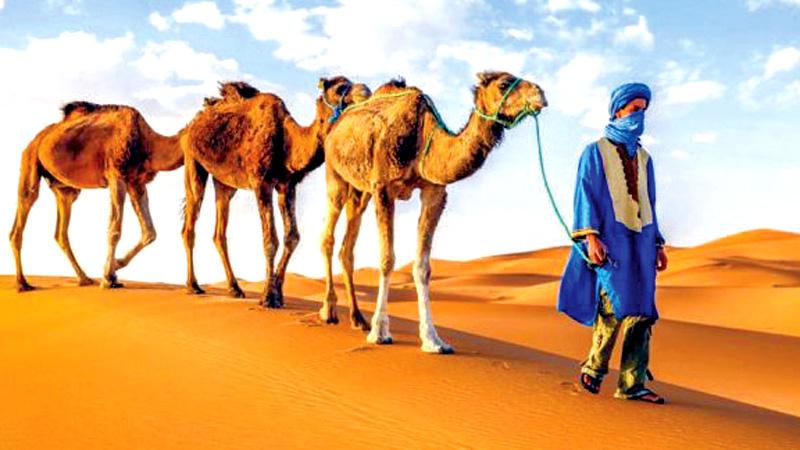
A tourist journeyed by camel to see the great Pyramids. He was swept away by the beauty of the desert night and the work-a-day world seemed to fade away from his memory. After absorbing all the glamour of the experience and desiring to preserve every detail of the dream-like world in which he found himself, he remounted the camel, at the same time asking his Arab guide, “What’s the name of my camel?” “Greta Garbo,” replied the guide.
Out of all members of the animal kingdom, the camel is a great mystery of nature. According to legend, only the camel knows the 100th name of Allah. From time immemorial, it has been a mode of transportation, especially in deserts. The Bedouin call their country “The mother of the camel.” The camel is native to the desert regions in Asia and Northern Africa. It has been domesticated since ancient times.
The Arabian camel has one hump. The Bactrian camel has two humps. The two-hump camels are usually found in Central Asia. They are really beasts of burden. The humps are stores of flesh and fat, absorbed as nutrition when food is scarce. Its stomach has many pouches to store water. The Arabian camel stands 1.8m (6 feet) tall at the shoulder. The hump rises about 30 cm (12 inches) above the back. The Bactrian camel has shorter legs.
The Bactrian camel can carry loads as great as 454 kg. Although its pace is only about four kilometers per hour, it can travel around 47 km in a day. The Arabian camel can cover over 161 km in a day. The milk and flesh of the camel are used as food and the hide for leather. The long camel hair is made into cordage and fine paint-brushes. They also use it to make clothes and tents. The people in Arabian countries ride camels, beat them, bet on them, sleep in their shadows and finally eat them. Sometimes, they cut them open for water.
Unusual capacity
The camel has the unusual capacity to survive for long periods without food or water as it preserves the fat in its hump. Therefore, it is called the “Ship of the Desert.” The camel has always been treated as a wonderful creation. If you look at a camel carefully, you will notice that it has a comic face only a cartoonist can draw. Its eyes are bottle-green at night. Its eyelashes are as long as Sheridan’s. It can close its nostrils against sand blowing. Like a cow, it chews its own cud and eats even thorny plants in the desert.
In comparison to other animals, except the elephant, the camel is a huge creature. The average length of a full-grown camel is about ten feet. Its height is about seven feet with its padded feet. Although it can gallop at 15 miles per hour, it prefers to walk leisurely. The camel lives for about 40 years.
It is, perhaps, the only animal that can travel long distances on the desert without water. While walking, it sucks back the half-chewed cud from the stomach and starts chewing it again. Camels come in a variety of colours ranging from reddish-brown, brown, yellow and white. They are symbols of wealth. If you possess 50 camels, you are a rich person.
Camels feed on guddha leaves, dried plants, grass and withering tribulus. The camel is an unpredictable animal as far as its behaviour is concerned. It is capable of attacking you without provocation. It can kick both ways – backward and forward. A kick can inflict serious injuries.
Sometimes, it bites anything including some parts of your body such as the shoulder. On the other hand, riding a camel is a challenging task. You can mount it only when it kneels down. Then you have to approach it from behind and catch the saddle tree. When it rises, it will fling you backward and forward.
Caravan moves on
Most camels die on the way due to thirst and fatigue. Sometimes, they cannot bear the extreme heat in the day and extreme cold at night. Some riders pour water down the camel’s nose to revive it. If it dies on the way, the caravan moves on leaving the dead animal on the desert.
Camel sport is an integral part of communities in the Middle East. Many people adopt camels as a profession and regular events are organised. The demand for special breeds of racing camels is quite high. Several regions have declared camel as their national animal and organise events at national level to promote and highlight camel rearing among local residents.
Camel urine is a natural product used for the management of several diseases in the Arabian region. Cancer patients are reported to be drinking camel urine alone or with milk. The urine is devoid of bad odour and toxicity due to the low urea and lack of ammonia in it.
Research on camel urine has shown that it has antifungal and antibacterial properties. It is known to protect the liver. It has gastroprotective and ulcer healing effects, researchers say. Camels contribute hugely to human survival in less agro-ecological parts of African, Asian and Arabian deserts. Nowadays, they are hugely important in many parts of the arid world as sustainable livestock species.
A poem penned by Eunice Clark on the camel is reproduced below:
The camel and the driftwood
The first to discover the camel
Fought shy of the newfangled mammal
The nest was less scared,
And the third fellow dared
To throw on the camel a trammel
Some shore watchers raised a great hue,
That a vessel of war was in view.
Then they thought ‘twas a sail,
Then a gig, then a ball,
At the end only driftwood hove to.
Dear reader, the distant or strange
Shrinks past as it comes within range
The most jaunty of men,
Heard again and again
Will jingle like very small change.
